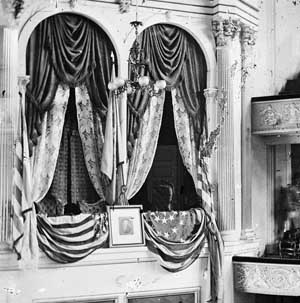At about 1 p.m. on April 15, 1865, Olympia and Seattle (probably at the same time) receive news by telegraph that President Abraham Lincoln (1809-1865) has died that morning from an assassin's bullet he received the night before. Lincoln was the 16th president of the United States of America, and guided the country through the Civil War.
News Arrives Five Hours Later
The Washington Democrat in Olympia reprinted the first news by telegraph transmission received from the East Coast via California as follows:
"Marysville, Cal. Saturday, April 15. President Lincoln was shot through the head at Ford's Theatre at Washington [D.C.] last night. Secretary Seward was simultaneously stabbed in his bed. The President died at 8:30 this morning. Seward about 9 o'clock."
There are misstatements in the telegraph. The president died at 7:22 a.m., not at 8:30. Secretary William Seward (1801-1872), secretary of state in Lincoln's cabinet, was badly injured, but survived the stabbing. In 1867 he would negotiate the purchase of Alaska from the Russians.
Shock and Sorrow
In Seattle, the Union party had already scheduled a political meeting at the University of Washington Assembly Hall (then located in downtown Seattle) for the afternoon of April 15, 1865. Its original purpose was abandoned to mourn the death of the President and the supposed death of Secretary Seward.
Seattle gathered to mourn Lincoln's death in one of the largest meetings ever assembled here. The main speaker, the Honorable Selucius Garfielde, addressed the people in an "eloquent and thrilling" oration. In summary he stated:
"Deep as was the stain ... cast on the American Nation by this causeless and cruel rebellion, — low as we had sunk in our own estimation, we were to sink still lower. It had been our boast and pride, that [President Lincoln], our Ruler[,] was one of ourselves. No pomp or pageantry surrounded him; no body guard waited on him as he went forth, nor sentry kept a watch at his door, but, secure in that respect which his fellow citizens paid his station, let their politics be what they might, he had moved about unattended, in the darkness of night, as the noon day sun. This was the most severe blow we had yet received, for it shook the confidence of man in his fellow-man and almost seemed to betoken a revival of scenes as bloody as had marked the French Revolution, but it was the last expiring struggle of slavery, and the blood of Abraham Lincoln, poured out on the altar of Freedom, had consecrated our soil forever, so that none but Freemen could hereafter breathe upon it. The assassin's knife had only added certainly to certainty" (Seattle Weekly Gazette).
The shock and sorrow apparently was shared by nearly everyone. Following President Lincoln's death, every Puget Sound newspaper printed black borders around all of their columns.
Years later an episode came to light that occurred when the news of Lincoln's assassination reached Seattle. Jake Harding, a fiddler who played for Seattle's first dance, and who used to "call" Quadrilles in Chinook Jargon for dances attended by both Indians and whites, worked at the time in the Eureka Bakery. In 1909 Harding recalled that when the news of the assassination came, "a sawyer in Yesler's mill, named Bill B. Dillon, said he was d----d glad it had happened." This fellow was chased for days, "for the purpose of hanging him from a tree, but he escaped in a canoe and was never seen again" (Seattle Post-Intelligencer, 1909).

